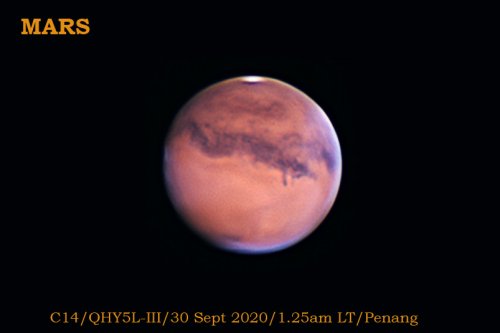

Planet Mars will be closest to the Earth on Oct 6th, 2020 (only 62.4 million kilometers!) If you miss this chance to see Mars, the next time you see Mars this big will be in 2035. (although in 2033, Mars will be a tad smaller than it is currently)
To see Mars, look toward northeast direction around 9pm. You should see a bright red star. If the sky is clear, you won't missed it as it is now one of the brightest object in the sky.....if you count the Sun as brightest, then the next brightest will be Moon, Venus, and normally Jupiter. However, Mars has now dethroned Jupiter to become the brightest object after Venus.
Viewing through a telescope, you should be able to see the south polar ice cap and some dark marking.
In the photo, the south polar ice cap is at the top. At the center, is the region of Insidis Planitia. Morning fog, seen as blue hazy feature, can be seen on the right side of the planet. While the bottom is the north polar region.
This photo was taken from my observatory in Penang on 30th Sept 2020 at 1.23am. Telescope used was Celestron C14 with QHY5L-III camera with 2x barlow

Copyright © 2008 Perseid Sdn Bhd.By Trilobyte








